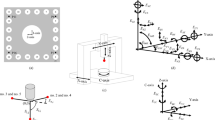Abstract
The NI-2 hole inclinometer, which was developed at the Institute of Physics of the Earth (IPE), Russian Academy of Sciences and which provides for monitoring of the plane position of the shaft of a hole at different levels with an accuracy to 2-3 mm is described; this inclinometer makes it possible to solve a broad circle of problems associated with the monitoring of displacements of a geomass and the deformations of structures.
Similar content being viewed by others
REFERENCES
V. B. Dubovskoi, Monitoring of deformation processes, Geologic-Engineering And Geophysical Monitoring of Natural Entities And Engineering Structures [in Russian], Moscow (1993), pp. 21-25.
A. S. Aleshin and V. B. Dubovskoi, System for the deformation monitoring of the beds of large-scale engineering structures, All-Russian Scientific-Technical Conference “Ecology And Geophysics” [in Russian], Moscow (1995), p 17.
A. S. Aleshin and V. B. Dubovskoi, Deformation monitoring of dangerous natural processes, Applied Geoecology, Extreme Situations, the Land Cadastre, and Monitoring [in Russian], No. 1, Moscow (1995).
A. S. Aleshin, V. B. Dubovskoi, V. A. Il'ichev, P. A. Konovalov, V. I. Leont'ev, and N. S. Nikiforova, High-accuracy deformation monitoring of structures surrounding the business and recreation complex “Manezhnaya Square,” Sergeev Readings [in Russian], No, 2, Moscow (2000), pp. 174-179.
Author information
Authors and Affiliations
Rights and permissions
About this article
Cite this article
Dubovskoi, V.B., Zhil'nikov, V.G., Kuklei, L.N. et al. NI-2 Hole Inclinometer. Soil Mechanics and Foundation Engineering 40, 104–108 (2003). https://doi.org/10.1023/A:1025491623978
Issue Date:
DOI: https://doi.org/10.1023/A:1025491623978




